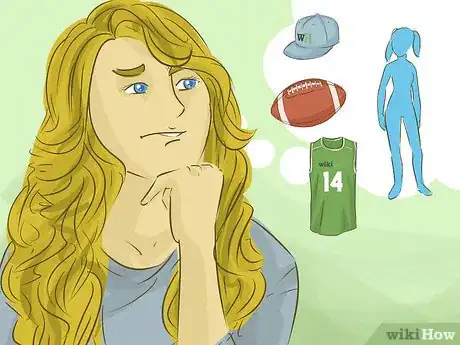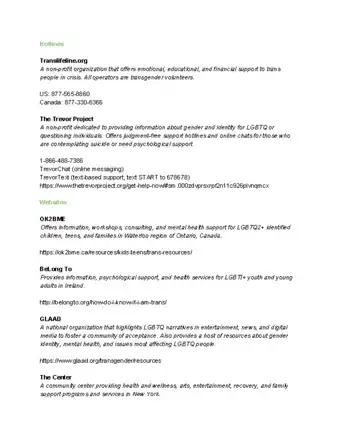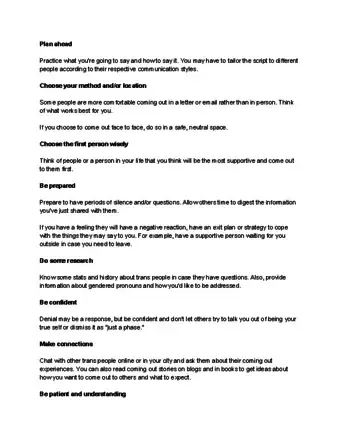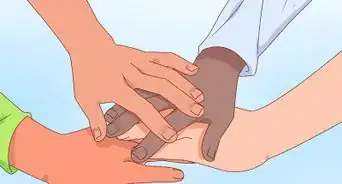This article was co-authored by wikiHow Staff. Our trained team of editors and researchers validate articles for accuracy and comprehensiveness. wikiHow's Content Management Team carefully monitors the work from our editorial staff to ensure that each article is backed by trusted research and meets our high quality standards.
There are 9 references cited in this article, which can be found at the bottom of the page.
wikiHow marks an article as reader-approved once it receives enough positive feedback. This article received 37 testimonials and 84% of readers who voted found it helpful, earning it our reader-approved status.
This article has been viewed 1,391,796 times.
Learn more...
While there are biological differences in the brains of transgender and cisgender people, there still isn't any simple test to take to say if the gender you were assigned at birth is correct.[1] Nonetheless, with some soul-searching and a little help from the experts, you can find the identity that suits you best. If you are seriously questioning your gender identity, get in touch with your feelings and embrace your uncertainty. Talk to a counselor who specialized in gender identity so that you have someone to support you through the process. Remember that there are many ways to identify, and the most important thing is to figure out what you want.[2]
Steps
Asking the Right Questions
-
1Acknowledge that you are curious. If you are seriously wondering whether or not you might be transgender, you're probably not fully gender conforming. This doesn’t necessarily mean that you are transgender, but it could. It may also mean that you are gender variant in another way.[3]
- Ask yourself why you are curious. If it's persistent discomfort with your assigned gender, or attraction to the image of yourself as a different gender, you may be transgender.
- Consider the possibility that you could be nonbinary: if you don't feel like you are exactly a man or a woman, you could be something else.
- If you feel comfortable with your assigned gender but you notice yourself acting out of step with other cisgender people, that doesn't necessarily mean you're transgender. You could just be a feminine man, or a masculine woman.
- Keep in mind that being transgender is not the same as being 'transsexual'. Transsexual is an older term used to describe people who have taken or want to take medical steps to permanently change their physical sex. Some transgender people may use hormones and even have surgery, but not all do. Many trans people find this term offensive, but some are okay with it and use it to describe themselves, so always ask before referring to a trans person as "transsexual".[4]
-
2Think about your childhood desires. Many transgender people showed strong signs of gender dissatisfaction as children. Persistent desires lasting more than six months are often understood as a sign of Gender Dysphoria. Signs include:[5]
- Insisting you are not the gender your parents say you are.
- Thinking you will grow up to be a gender other than your assigned one.
- Casting yourself as another gender during imagination games.
- Dressing up, or wanting to dress, in clothing associated with this gender.
- Preference for friends of this gender.
- Strong desire to participate in group activities, games, and pastimes typical of this gender.
- Rejection of gendered toys that correspond with your assigned gender.
- Dislike of your own anatomy and/or genitalia.
- Feeling sadness, fear, confusion, embarrassment, anger, or other emotions because of gender-related things.
Advertisement -
3Ask yourself if you identify with your social role. While cisgender people can still not fit into their typical social role, many transgender people feel alienated from the role they are asked to play in society. Ask yourself if you feel alienated from the things you are asked to do with other people of your gender. When you are asked to do something stereotypical of your assigned gender, do you feel like you are being put in the wrong box?[6]
- If you feel like you're being put in the wrong box, you might consider that those are other people's boxes, not yours. You could choose to forget about boxes entirely, and just go about living life as yourself, whatever that means to you.
- Notice how you feel when you are with a group of people of your assigned gender. If you feel different, or like you are passing for one of them but are not really one of them, you may be experiencing dysphoria.
-
4Notice how your given name and pronouns make you feel. Think about the way you feel when you hear yourself referred to by your given pronoun. If you feel misidentified, it may be that you are due for a change of pronoun.[7]
- If you dread being addressed as "sir" or "ma'am," it may be that that term does not suit you.
- See how you feel when you are in a group and someone refers to you as "ladies" or "gentlemen."
- Notice if your name feels like the wrong one. If it does feel right, question whether you think of it as a "girls" name or a "boys" name.
- How do you feel when someone accidentally calls you by the pronoun of the so-called opposite gender? If it feels comfortable or gratifying, you may be transgender.
-
5Recognize body dysphoria. A common experience among transgender people is the sense of their body being incorrect in some way. This is different from Body Dysmorphia, as it's related to sex and/or gender. Some transgender people report feeling "trapped" inside their bodies. If you have a persistent desire to change your sexual characteristics, you may be experiencing dysphoria.[8]
- If the experience of puberty came as a shock or a trauma, this may be dysphoria. Try to recall if you were upset by the acquisition of secondary sex characteristics (deepened voice, breast development, broadened shoulders, facial hair, the onset of menstruation).
- If you avoid mirrors, getting your picture taken, or hide your body in layers of clothing, then this may also indicate that you could have some body dysphoria.
Getting Support
-
1Find a good gender therapist. There are many psychologists, counselors, and social workers who specialize in gender variance. These experts can help you ask and answer your big questions.
- Look for counselors who specialize in gender identity, Gender Dysphoria, or LGBT concerns.
- If there is a transgender health clinic in your area, contact them to see if they have any available therapists.
- If you live in the USA, you can use the American Psychologist Association locator to find a psychologist who specializes in questions of gender identity: http://locator.apa.org/
- In the UK, consider contacting the Beaumont Society for a reference: http://www.beaumontsociety.org.uk/
- You can also ask your doctor for a recommendation, or visit a counselor at your school if you are in high school or college.
-
2Talk to gender variant and questioning people. Get in touch with people who have transitioned, people who are questioning their gender, and gender non-conforming cisgender people. Some places you might look include LGBTQ meet up groups, community centers, and events. If you are in school, consider visiting any student groups such as an LGBTQ group or a Gay Straight Alliance. You don't have to come out right away; just say you are an ally, or explain that you are questioning but you aren't comfortable talking about it just yet.
- Not everyone you meet will want to talk about their gender! Some people may feel exposed if you ask them personal questions. You can mention your own questions, and if they ask you questions you can ask in return.
- If you're not sure, write them or find a private moment to ask. You might say, "I've been thinking a lot about my own gender identity, and you are someone who might know about some of the questions I am having. If you ever have the time and energy, I would love to talk to you about this. Please feel free to say no."
-
3Explore online forums. A great way to connect with other gender variant and questioning people is to look online. Consider joining a group on social media, or an anonymous forum. When you interact with people online, make sure to conceal your personal information.
- Check out a general LGBTQ forum like: http://emptyclosets.com/forum/
- If you are 13-24 years old, you can join TrevorSpace for a safe, monitored forum: https://www.trevorspace.org/login
- You can also look into organizations like PFLAG (Parents, Families and Friends of Lesbians and Gays) and GLAAD to find resources and support for yourself and your family.[9] [10]
Figuring Out What You Want
-
1Give yourself the option of identifying as the opposite gender. If you think you may be a trans man or a trans woman, give it a try to see how you feel. Consider setting aside a weekend in which you think of yourself as that gender. If you are sharing these questions with a friend, a therapist, or a family member, tell them your plans and ask for their support.[11]
- Try out other pronouns. See how you feel when you refer to yourself with pronouns other than those you were assigned. If you think you might be a trans woman, call yourself "she" and "her," and ask a confidant to do the same.
-
2Consider the possibility of being nonbinary. There are so many ways of expressing a gender beyond "man" and "woman." You may be agender, bigender, or something else entirely. There's no need to squeeze yourself into a box if that box doesn't fit you.[12]
- Try using "they/them" pronouns. If you don't feel like a "he" or a "she," or if you are looking for a way to communicate your gender to others, try gender neutral pronouns.
- Keep in mind that you can take your time, and you may decide that you do not want to make a change at all. Don’t let other people pressure you.
-
3Dress to express yourself. Experiment with clothing until you find a way of dressing that feels right to you. If you are strongly drawn to certain clothing, wear it. For instance, if you were assigned male but you always wanted to wear dresses, go for it. You'll learn a lot from how it feels to wear whatever you want.[13]
- If you feel like you're nonbinary, experiment with an androgynous look, or mix and match typically gendered clothing.
-
4Consider other ways to affirm your gender. Whatever gender you identify with, there isn't any one way to affirm it. Ask yourself what you want: what would make you feel the most yourself? Go over these questions with a counselor if you are feeling confused.
- Consider changing your name.
- Think about asking others to call you by different pronouns, such as she/her, he/him, or they/them, or even neopronouns.
- Come out to people in your life if you feel safe doing so. You can come out as transgender or tell people you are questioning your gender.
- Think about your body. Would you like it to be more feminine or masculine? You might cut or grow your hair, take hormones, get top or bottom surgery, or change nothing at all.
Help Handling Transgender Issues
References
- ↑ https://www.nih.gov/news-events/nih-research-matters/sex-differences-brain-anatomy
- ↑ https://www.scientificamerican.com/article/is-there-something-unique-about-the-transgender-brain/
- ↑ http://www.apadivisions.org/division-44/resources/advocacy/transgender-adolescents.pdf
- ↑ https://www.glaad.org/reference/transgender
- ↑ https://psychcentral.com/disorders/gender-dysphoria-symptoms/
- ↑ https://psychcentral.com/disorders/gender-dysphoria-symptoms/
- ↑ http://www.apadivisions.org/division-44/resources/advocacy/transgender-adolescents.pdf
- ↑ http://www.nhs.uk/Conditions/Gender-dysphoria/Pages/Introduction.aspx
- ↑ https://www.pflag.org/
About This Article
If you want to know if you’re transgender, think about how your given name and pronouns make you feel. For example, see if you feel like your name is wrong because it’s too much like a “girl” or “boy” name. You can also observe whether you hate being addressed as “sir” or “ma’am.” Since body dysphoria, or the sense of your body being incorrect in some way, is a common experience for transgender people, consider if you feel “trapped” in your body. You can also reflect on whether your sex characteristics like your deep voice, breasts, facial hair, or menstruation upset you. If you need more support while figuring out your gender identity, check out LGBTQ groups at your school or in your community. For more advice from our co-author on understanding body dysphoria, read on!

















-Step-21.webp)


-Step-26.webp)






-Step-16.webp)














-Step-21.webp)


































